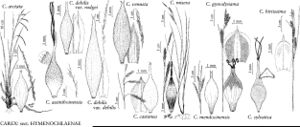Carex venusta
Amer. J. Sci. Arts 26: 107, plate T, fig. 62. 1834.
Plants densely cespitose. Culms dark maroon at base; flowering-stems 30–90 cm, longer than leaves at maturity, 0.8–1 mm thick, glabrous but scabrous within inflorescence. Leaves: basal sheaths maroon, bladeless, glabrous on back; others grading from maroon to green on back, pale brown-hyaline and red dotted on front, pubescent near apex; blades flat, 2.8–7.2 mm wide, glabrous on both surfaces, margins smooth or finely scabrous. Inflorescences: peduncles of lateral spikes slender, 5–100 mm, finely scabrous; peduncle of terminal spike less than 15 mm, finely scabrous; proximal bracts equaling inflorescences or shorter; sheaths 10–70 mm; blades 1.5–3.5 mm wide. Lateral spikes 3–5, 1 per node, well separated, erect to nodding or drooping at maturity, pistillate with 10–40 perigynia attached 1–3 mm apart, narrowly oblong-cylindric, 10–50 × 4–5 mm. Terminal spike staminate or sometimes gynecandrous with a few pistillate flowers distally, 12–55 × 1–2 mm. Pistillate scales suffused with reddish-brown to chestnut with hyaline margins and broad green midrib, ovateoblong, shorter than mature perigynia, apex obtuse, acute, or sometimes mucronate, glabrous except scabrous midrib. Perigynia olive-green, copiously red dotted, conspicuously 10–12-veined, veins about equal in size, loosely enveloping achene, ovoid-ellipsoid to lanceovoid, 4.6–9 × 1.2–2.2 mm, membranous to coriaceous, base with short stipe, apex tapering to very short beak, glabrous or short-pubescent; beak minutely bidentate, 0.3–0.8 mm, ciliate between apical teeth. Achenes distinctly stipitate, 2–2.5 × 1–1.5 mm, stipe 1–1.5 mm. 2n = 42, 44, 46, 48, 50.
Phenology: Fruiting late spring–early summer.
Habitat: Swamp forests, bogs, wet places in pine forests, bays, hammocks, roadside ditches
Distribution

Ala., Del., D.C., Fla., Ga., La., Md., Miss., N.J., N.Y., N.C., S.C., Tenn., Va.
Discussion
Carex venusta has been divided into two varieties: one with glabrous perigynia and slightly smaller perigynia and the typical variety with pubescent perigynia. Both varieties are named from types from the Gulf coastal plain. Varieties are not recognized here because variability in the characters used to separate them is greater within populations than between populations. However, there do seem to be two taxonomic entities within this species: one with a distribution from Texas to North Carolina and the other with a distribution from North Carolina to Long Island, New York. The two groups differ slightly in perigynium size and shape and have different, but overlapping, series of chromosome numbers and strikingly different allozyme patterns (M. J. Waterway 1988). The northern group always has glabrous perigynia while the southern group has both glabrous and pubescent perigynia, often in the same population. Whether to recognize these variants as varieties of C. venusta or as distinct species is the subject of ongoing study. Hybrids between both groups and C. debilis have been confirmed.
Selected References
None.
Lower Taxa
"shortened" is not a number."thick" is not a number.
